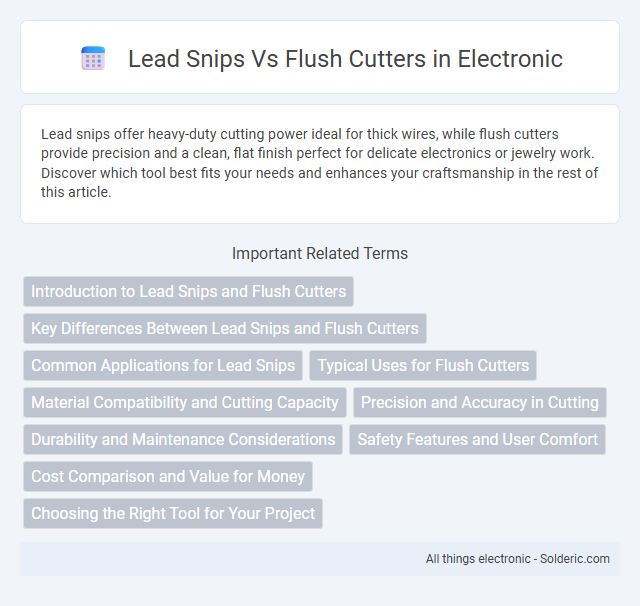Lead snips offer heavy-duty cutting power ideal for thick wires, while flush cutters provide precision and a clean, flat finish perfect for delicate electronics or jewelry work. Discover which tool best fits your needs and enhances your craftsmanship in the rest of this article.
Comparison Table
| Feature | Lead Snips | Flush Cutters |
|---|---|---|
| Primary Use | Cutting lead, soft metals, and wires | Cutting electronic component leads close to the board |
| Blade Type | Concave or straight cutting edges | Sharp, flush-cut blades for precise cuts |
| Cutting Precision | Moderate precision | High precision, leaves smooth edges |
| Typical Material Cut | Lead, copper, aluminum wires | Thin metal leads of electronic components |
| Handle Type | Comfort grip for heavy-duty use | Ergonomic grip designed for fine control |
| Price Range | Low to mid-range | Mid to high-range |
| Common Industries | Electrical, metalworking, and construction | Electronics, PCB assembly, and hobbyist work |
| Example Brands | Klein Tools, Wiss, Milwaukee | Xcelite, Hakko, Engineer |
Introduction to Lead Snips and Flush Cutters
Lead snips are heavy-duty cutting tools designed for thick materials like lead sheets and metal rods, offering precise, angled cuts with robust leverage. Flush cutters provide sharp, clean cuts close to the surface, ideal for trimming wires and fine components in electronics or jewelry making. Choosing the right tool enhances your cutting efficiency and ensures cleaner, more accurate results for your project needs.
Key Differences Between Lead Snips and Flush Cutters
Lead snips and flush cutters differ primarily in their design and cutting precision; lead snips feature robust, angled blades ideal for cutting through tough materials like lead sheets, while flush cutters have sharp, flat blades engineered for precise, close-to-surface cuts on wires and electronic components. The cutting angle of lead snips allows for strong leverage and clean cuts in thick metals, whereas flush cutters provide a clean, flush cut without leaving sharp wire tips, crucial for electronics work. Material durability and cutting application define their use cases, with lead snips suited for heavier tasks and flush cutters optimized for delicate, detail-oriented trimming.
Common Applications for Lead Snips
Lead snips are commonly used in metalworking and plumbing for cutting soft metals like lead, copper, and aluminum sheets with precision and ease. Their robust design allows you to trim roofing materials, flashing, and ductwork accurately, making them essential for HVAC installation and repair. Unlike flush cutters, lead snips provide greater leverage and cutting power ideal for thicker, tougher metals in construction and craft projects.
Typical Uses for Flush Cutters
Flush cutters are specially designed for precision trimming of wire and component leads in electronics, allowing clean cuts close to surfaces without damaging surrounding areas. They are commonly used in circuit board assembly and repair to remove excess wire leads and to create neat, professional finishes on solder joints. Their sharp, flat cutting edges enable effective handling of fine gauge wires and delicate materials in tight spaces.
Material Compatibility and Cutting Capacity
Lead snips excel in cutting thicker, softer metals such as lead, copper, and aluminum due to their robust construction and larger jaw design, making them ideal for heavy-duty tasks. Flush cutters provide precise cuts on finer materials like electronic wires and small-gauge steel, thanks to their sharp, angled blades designed for tight spaces and clean finishes. Your choice depends on the material type and thickness you frequently encounter, ensuring optimal cutting performance and tool longevity.
Precision and Accuracy in Cutting
Lead snips provide superior cutting precision for thicker wires and soft metals, allowing for clean, controlled cuts necessary in heavy-duty applications. Flush cutters excel in delivering highly accurate, close-to-surface cuts ideal for delicate tasks like electronics and fine jewelry work. Choosing between these tools depends on the material thickness and the required cutting precision for the project.
Durability and Maintenance Considerations
Lead snips typically offer superior durability due to their robust, forged steel construction ideal for cutting through tough metals, whereas flush cutters, designed for precision trimming of softer materials like wires and leads, may wear out faster with heavy use. Maintenance for lead snips involves regular sharpening and lubrication to maintain cutting efficiency, while flush cutters require careful cleaning and occasional blade replacement to ensure clean cuts without damage. Your choice should reflect the frequency and type of material you work with to balance longevity and upkeep effectively.
Safety Features and User Comfort
Lead snips offer ergonomic grip designs with cushioned handles that reduce hand fatigue, enhancing user comfort during extended use. Flush cutters provide precision cutting with safety springs that minimize accidental pinching and improve control. Both tools prioritize safety by incorporating non-slip handles and robust blade guards, ensuring secure operation and reducing injury risks.
Cost Comparison and Value for Money
Lead snips typically cost between $10 and $25, offering durable, heavy-duty cutting suited for metal and thick materials, making them a cost-effective choice for frequent use in construction and plumbing. Flush cutters range from $15 to $40, providing precise, clean cuts ideal for electronics and delicate work, which justifies their higher price for specialized tasks. Evaluating value for money depends on the application: lead snips deliver long-lasting performance for robust jobs, while flush cutters offer superior accuracy and finish quality for finer projects.
Choosing the Right Tool for Your Project
Lead snips offer powerful cutting ability for thicker materials like metal sheets, making them ideal for heavy-duty projects requiring precision and strength. Flush cutters provide clean, close cuts on softer materials such as wires and electronic components, ensuring a neat finish without damaging surrounding elements. Selecting the right tool depends on the material thickness and desired cut quality, with lead snips suited for robust tasks and flush cutters perfect for delicate, detailed work.
Lead snips vs flush cutters Infographic

 solderic.com
solderic.com